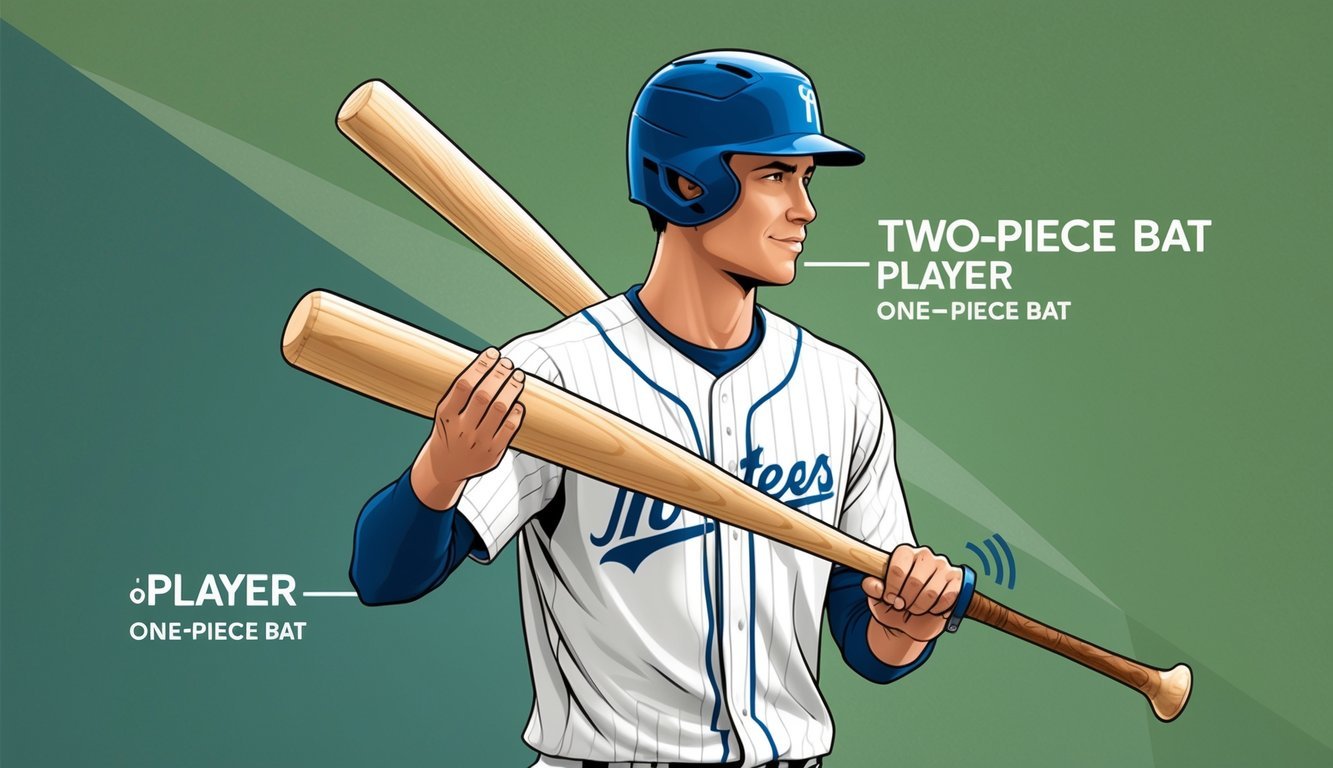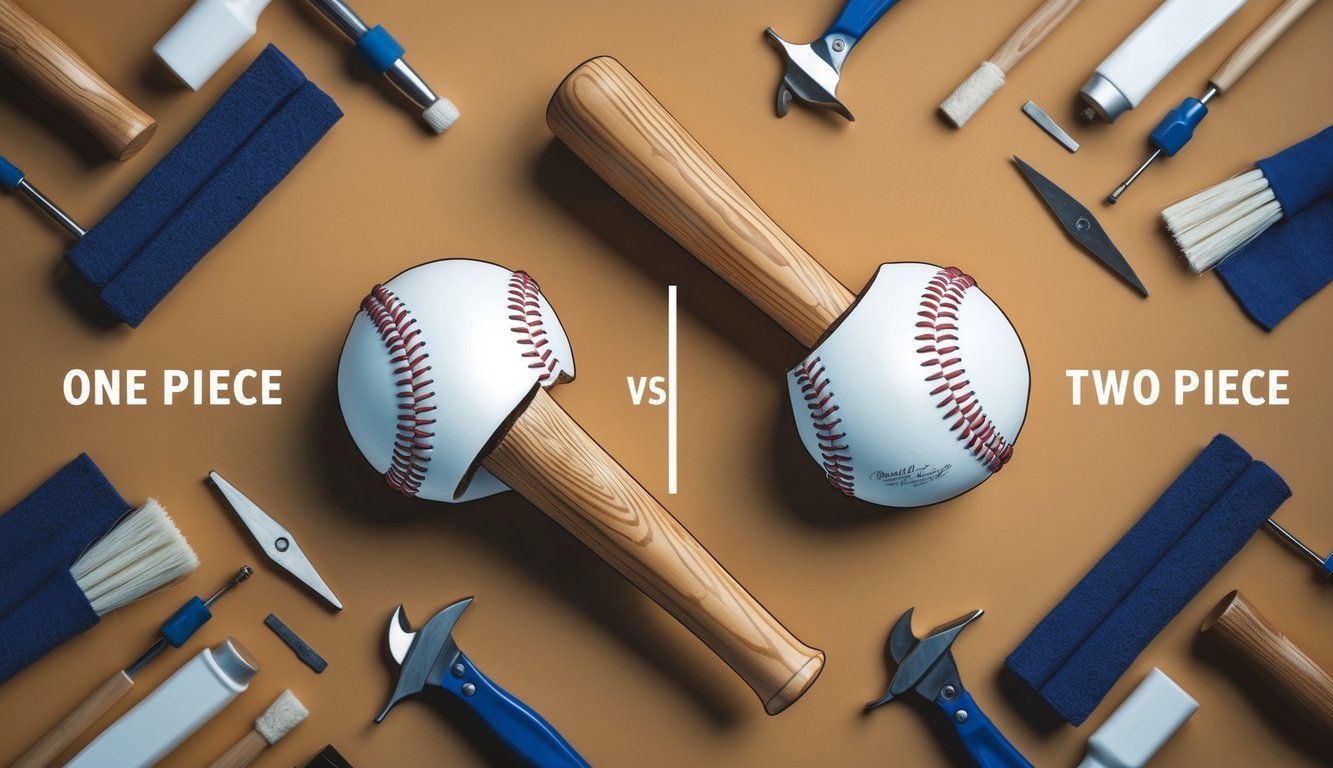When shopping for a new baseball bat, players face an important decision: one-piece or two-piece construction.
One-piece bats are crafted from a single piece of metal or composite material.
They offer a stiffer feel and more feedback on contact.
On the other hand, two-piece bats feature separate barrel and handle components joined together.
This provides increased flex and a whip-like effect during swings.
The choice between one-piece and two-piece bats depends on a player’s individual style, strength, and preferences. Power hitters with above-average bat speed often gravitate towards one-piece bats for their solid feel and potential for increased power transfer.
On the other hand, players seeking more forgiveness on mishits and enhanced bat speed may prefer two-piece designs.
Both bat types have their merits in baseball and softball.
One-piece bats typically cost less and offer greater durability.
Meanwhile, two-piece bats can provide a larger sweet spot and reduced vibration on off-center hits.
Ultimately, trying out different models and consulting with coaches can help players find the perfect bat to elevate their game.
Understanding One-Piece and Two-Piece Bats
Baseball bats come in two main designs: one-piece and two-piece.
These designs differ in their construction, materials, and performance characteristics, offering players unique advantages on the field.
Material and Construction
One-piece bats are crafted from a single material, typically aluminum, wood, or composite.
The entire bat is molded or carved as one continuous unit.
This construction provides maximum stiffness and power transfer.
Two-piece bats combine separate handle and barrel components.
These parts can be made from different materials, such as an aluminum handle with a composite barrel.
The pieces are fused together using advanced bonding techniques.
Hybrid bats, a subset of two-piece designs, mix metal and composite materials.
For example, they might feature an aluminum barrel with a composite handle.
This combination aims to provide players with the best of both worlds, as the aluminum barrel offers excellent pop and distance, while the composite handle enhances grip and comfort during play.
When considering purchasing a bat, many players engage in a composite bats vs aluminum bats comparison to determine which design best meets their performance needs.
Ultimately, the choice often hinges on personal preference and the specific requirements of the game.
Design Differences
One-piece bats offer less flex during swings, resulting in more direct energy transfer to the ball.
They provide consistent feedback, which some players prefer for better control.
Two-piece bats allow for more flex between the handle and barrel.
This design can increase bat speed and reduce vibration on mishits.
The separate components enable manufacturers to fine-tune performance characteristics.
Two-piece bats often incorporate specialized joining technologies.
These connections aim to optimize the bat’s “whip” effect, potentially increasing swing speed and power.
Performance Factors
One-piece and two-piece bats offer distinct performance characteristics that can significantly impact a player’s game.
These differences affect key aspects of hitting, including power, control, and overall comfort at the plate.
Swing Speed and Weight
Bat speed is crucial for hitting success.
Two-piece bats often provide a lighter swing weight due to their construction.
This design allows for quicker bat speed through the zone, potentially increasing a player’s ability to catch up to fast pitches.
One-piece bats typically have a more end-loaded feel.
While this can slow down swing speed slightly, it offers more mass behind the ball at contact.
Players who prefer a heavier swing may find one-piece bats more suitable.
The barrel and handle connection in two-piece bats can create a whip-like effect.
This may help players generate additional bat speed, similar to how a golf club flexes during a swing.
Power and Control
One-piece bats are known for their stiff feel and power transfer.
The solid construction allows for maximum energy transfer from the swing to the ball upon contact.
This can result in more power, especially for players with strong swings.
Two-piece bats offer a different approach to power.
Their flex can help players square up the ball more consistently.
This design may benefit contact hitters who prioritize consistent barrel-to-ball contact over raw power.
The sweet spot size can vary between the two types.
Some two-piece bats feature larger sweet spots, potentially improving a player’s chances of solid contact.
Vibration and Comfort
Vibration management is a key factor in bat comfort.
Two-piece bats excel in this area, as the separate handle and barrel can absorb and dissipate vibrations more effectively.
This reduces the sting felt in a player’s hands on mis-hits.
One-piece bats transmit more feedback to the hands.
While this can be uncomfortable on off-center hits, some players prefer the direct feel it provides.
It allows for immediate feedback on contact quality.
The reduced vibration in two-piece bats can lead to increased comfort during long batting practice sessions.
This may help players maintain proper form for longer periods without fatigue from repeated vibrations.
Player Considerations

Selecting between one-piece and two-piece bats depends on individual factors.
Players must consider their hitting style, preferences, and league requirements when making this choice.
Hitting Style and Preferences
Power hitters often gravitate towards one-piece bats like the Marucci Cat or Louisville Slugger Omaha.
These bats offer less flex and a stiffer feel, allowing strong players to generate more power on contact.
Contact hitters may prefer two-piece bats such as the DeMarini CF Zen.
These bats provide more flex and a smoother feel at the plate.
The “whip” effect can help increase bat speed for players who rely on timing and precision.
Personal preference plays a significant role.
Some players enjoy the solid feedback of a one-piece bat, while others appreciate the reduced vibration of a two-piece design.
League and Certification Requirements
Different leagues have specific bat regulations.
BBCOR certification is standard for high school and college play, limiting bat performance.
Youth leagues often have their own rules.
Some may require USA Baseball or USSSA certifications.
Players must ensure their chosen bat meets league standards.
This applies to both one-piece and two-piece designs.
Certain models, like the Rawlings 5150 or DeMarini Voodoo, come in various certifications to suit different league requirements.
Always check current league regulations before purchasing a new bat to ensure compliance.
Choosing the Right Bat

Selecting the ideal bat involves considering feel, performance, and personal preferences.
The choice between one-piece and two-piece designs impacts power, speed, and overall playing experience.
Pros and Cons
One-piece bats offer superior stiffness and power transfer.
They’re excellent for strong hitters who can generate substantial bat speed.
However, mishits can sting the hands more.
Two-piece bats provide a smoother feel and better vibration dampening.
They’re more forgiving on off-center hits, making them popular among contact hitters.
The flex between barrel and handle can increase bat speed.
Both types come in wood and metal versions.
Aluminum barrels often feature a trampoline effect, enhancing ball exit speed.
Performance vs Price
One-piece bats typically cost less due to simpler construction.
They’re durable and can offer great value for power hitters.
Two-piece bats are usually pricier but provide advanced features.
The separate handle and barrel allow for material combinations, potentially improving performance.
For players seeking maximum power on a budget, one-piece bats shine.
Those prioritizing feel and versatility might find two-piece designs worth the extra investment.
Length and Weight Options
Bat length and weight significantly impact swing speed and control.
One-piece bats often come in a wider range of weight options.
Two-piece designs allow for more balanced weight distribution.
This can help players generate faster swing speeds without sacrificing barrel mass.
Younger players or those still developing strength might prefer lighter, more balanced two-piece bats.
Power hitters often gravitate towards end-loaded one-piece models.
Testing different lengths and weights is crucial.
The right combination helps players drive the ball consistently and build confidence at the plate.
Tips for Maintenance and Care

Proper maintenance is key to extending the life of your baseball bat, whether it’s a one-piece or two-piece model.
Always store your bat in a cool, dry place to prevent warping or damage.
Clean your bat after each use with a soft cloth to remove dirt and debris.
For deeper cleaning, use a mild soap solution and wipe gently.
Rotate your bat regularly during use to distribute impact evenly across the barrel.
This helps prevent premature wear in one area.
For two-piece bats, check the connection point periodically for any signs of loosening or damage.
If issues arise, consult the manufacturer or a professional for repairs.
Avoid extreme temperatures, as they can affect the bat’s performance and structural integrity.
Never leave your bat in a hot car or freezing garage.
Use bat tape or grip enhancers to maintain a secure hold and protect the handle.
Replace these accessories when they show signs of wear.
When not in use, consider using a bat sleeve or case for added protection during storage and transport.
This helps prevent scratches and dings.
